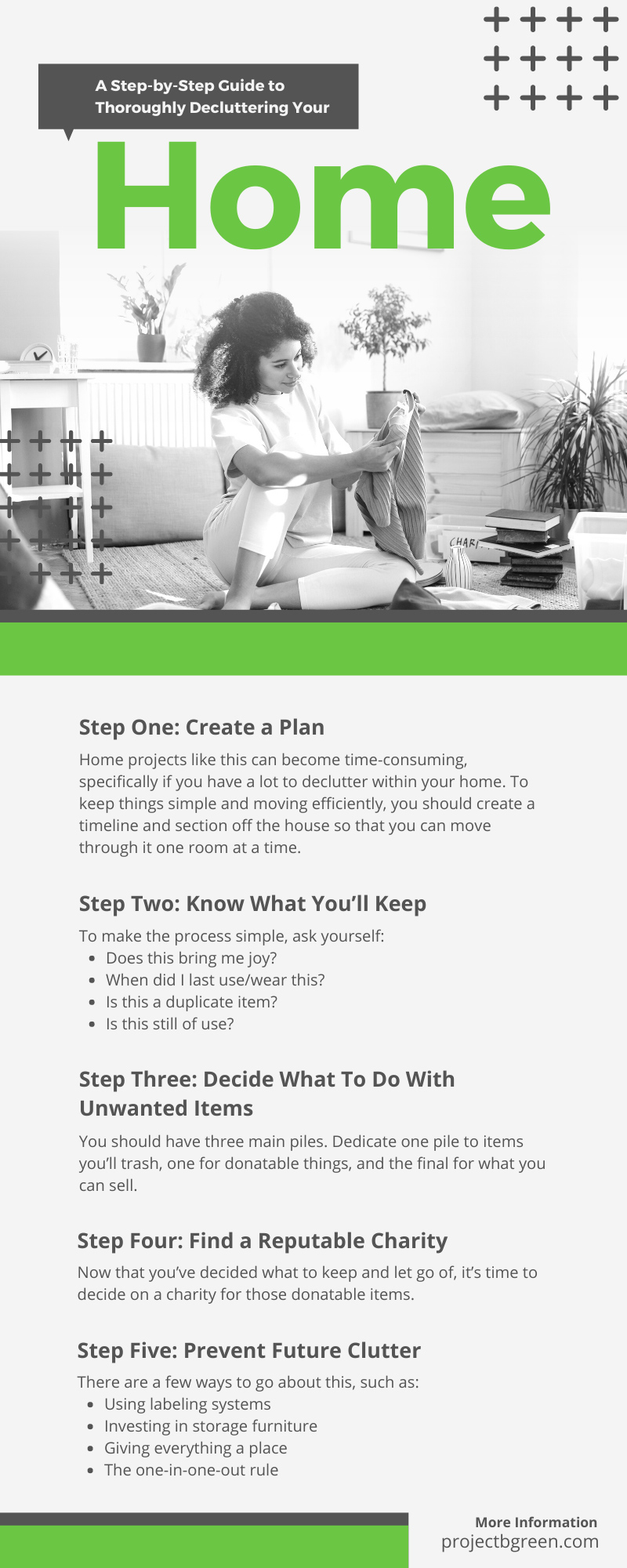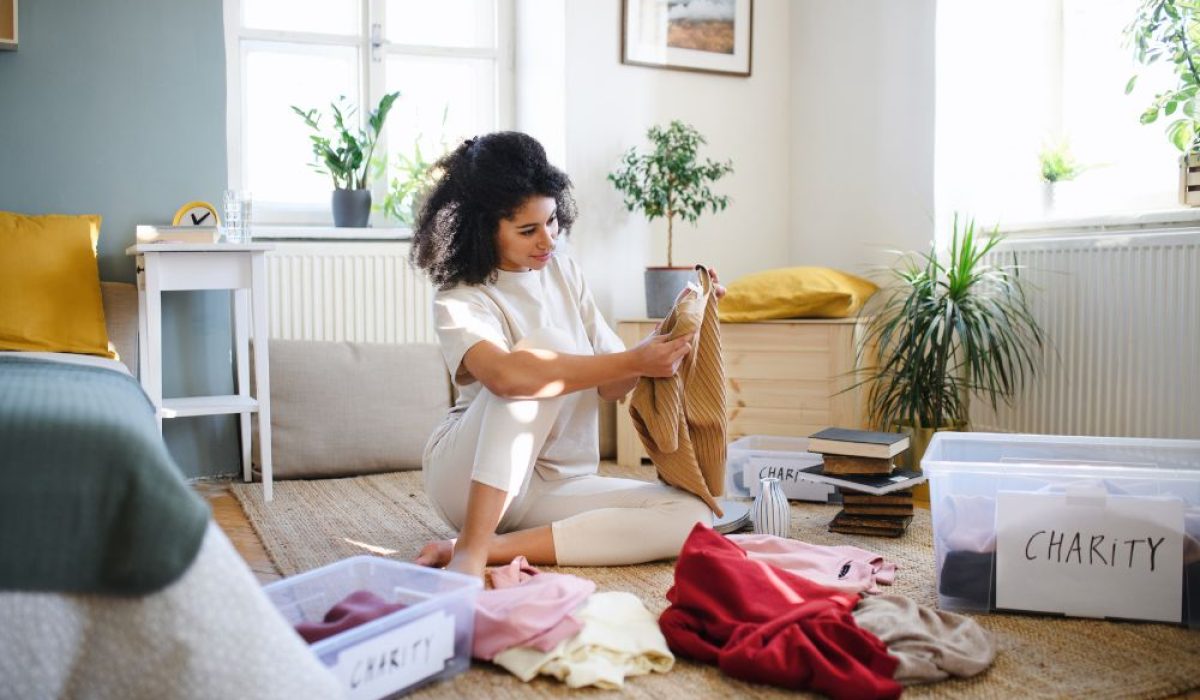Decluttering the house is a fantastic way to tidy things up and open space for new belongings. You may have a lot to sort through and determine whether you’ll keep it or toss it. Keep reading this step-by-step guide on how to thoroughly declutter your home to make the process easy.
Step One: Create a Plan
Home projects like this can become time-consuming, specifically if you have a lot to declutter within your home. To keep things simple and moving efficiently, you should create a timeline and section off the house so that you can move through it one room at a time.
Create a Timeline
You first need to walk through your home and determine how long it will take you to declutter. The length of the process depends on a few factors.
- How much time you’ll dedicate each day toward cleaning
- How large your house or cluttered zone is
- How many items you have to sort through and organize
Some people complete this task in two or three days, but for others, it could take a week—and there’s no shame in giving yourself time. You may have to juggle this task alongside work and other life commitments. However, you should dedicate time to focus on it so that it doesn’t drag out for too long.
Bonus Tip
Make sure everyone in your household knows about the plan and has a job to do for decluttering. For example, have children focus on their bedroom or the playroom while you work in a separate area; you can check their work once they finish.
Section off the Home
Trying to tackle every room at once isn’t always the most efficient method, so strive to section off the home and spend a day on each area. If you have a basement, start there and work your way upstairs. If you have a large household, you could assign members to different areas. However, you should always stick to one floor at a time. This prevents you from creating a bigger mess as you pile up clutter throughout the home rather than in a designated area.
Step Two: Know What You’ll Keep
Now that you have a plan, it’s time to get to work! The next step in this at-home decluttering guide is to determine what belongings you’d like to keep. To make the process simple, ask yourself:
- Does this bring me joy?
- When did I last use/wear this?
- Is this a duplicate item?
- Is this still of use?
If you answer yes to these questions or the items have sentimental value to you, place them in a safe area dedicated to the things you’ll keep. This should be far from the stuff you no longer want to ensure nothing ends up in the wrong pile by mistake.
Step Three: Decide What To Do With Unwanted Items
You should have three main piles. Dedicate one pile to items you’ll trash, one for donatable things, and the final for what you can sell. Consider labeling these piles using different colored bins or boxes to help everyone understand the cleaning system.
What You’ll Trash
If an item appears heavily worn or broken, you can’t donate it and definitely can’t sell it. When you throw it away, note whether the object is trash or recyclable. Although someone else may not get use out of it if it’s broken, you can still help the planet by properly disposing of it!
What You’ll Donate
Charities accept gently used or worn items, and giving things away is a wonderful way to declutter. Not everything you come across belongs in the trash. Knowing someone else will love the things you gave away is rewarding.
Take extra time to sort through wardrobes, toy chests, linen closets, and bookshelves. These areas hold some of the best things you can give away. Ensure you place all the donatable items in a box or bag for a safe trip to the nearest charity.
What You’ll Sell
You may have some valuable items or furniture that doesn’t belong in the trash. When this occurs, sell things online or have a garage sale to rid of these kinds of items.
Step Four: Find a Reputable Charity
Now that you’ve decided what to keep and let go of, it’s time to decide on a charity for those donatable items. Begin by searching out organizations near to your heart. If, for example, you advocate for children’s well-being, consider donating to an organization that focuses on helping kids.
You should always look into a charity’s reputation to ensure they uphold the principles they claim. Read through ratings, past fundraising events, and evidence of their impact on the community their programs support.
Bonus Tip
Project B Green is a for-profit organization that partners with local charities. We accept all sorts of gently used belongings you’ll encounter while decluttering. And if you don’t have time to drop off belongings, you can schedule a home donation pickupwith us!
Step Five: Prevent Future Clutter
The final step is to organize your home to ensure you don’t have another collection of clutter in the near future. There are a few ways to go about this, such as:
- Using labeling systems
- Investing in storage furniture
- Giving everything a place
- The one-in-one-out rule
Using these methods keeps the house organized and gives you a better idea of what you have so that you know when it’s time to clean again.
Label Belongings
Consider labeling the things you keep in the closet or on shelving units so that it’s easier to find when you need them. You can keep each type of clothing—sweaters, dresses, T-shirts—on separately colored hangers. Likewise, place bath products and linens in bins with labels stating what’s inside.
Invest in Storage Furniture
Multi-purpose furniture can be a lifesaver if you have more items than you do space. Some ottomans open and allow for blanket and pillow storage, making it easier to eliminate piles of these comfort essentials.
Give Everything a Space
Every belonging you own or decide to keep should have a “home” within your home. Not only will this keep things organized, but it will also display what you have. If all your shoes go in the coat closet, it’ll be easier to know when to sort through them if the pairs begin to pile up.
One-In-One-Out
Some of us love shopping, which is fine, but it can lead to quite a bit of clutter if you don’t take preventative measures. If you know this about yourself, consider following the one-in-one-out rule when buying new clothing, décor, books, or other items.
This way, you’ll get rid of something after each purchase to prevent future clutter. And remember, when the time does come to get rid of old, gently used belongings, donating them is a great way to say farewell to them.


